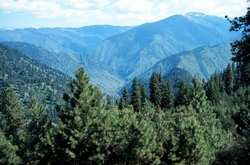Plaintiffs Contend USFS in Violation of Wilderness Act
A number of anti-aviation environmental and outdoor recreation groups have filed a lawsuit against U.S. Forest Service officials. The suit alleges the agency, by dint of the named officials’ malfeasance, allowed and even encouraged the 'illegal' use of remote airstrips in an Idaho wilderness.

Plaintiffs Wilderness Watch, Great Old Broads for Wilderness, Friends of the Clearwater, and Friends of the Bitterroot, set forth in the suit that federal officials violated both the federal Wilderness Act of 1964 and the Central Idaho Wilderness Act by allowing recreational pilots to conduct flight-operations at the Simonds, Vines, Mile Hi, and Dewey Moore airstrips—known collectively as the Big Creek Four. Subject airports, to the one, lie within the Frank Church-River of No Return Wilderness—a national forest in east-central-Idaho’s Lemhi County.
The lawsuit alleges recreational pilots’ use of the Big Creek Four has “exploded in recent years” and is marring the pristine state and historic solace of the wilderness. Plaintiffs contend none of Big Creek Four sites were regularly used as landing strips when the Frank Church Wilderness was designated a national forest in 1980; rather, they were deemed emergency landing areas. Ergo, the sites are not “grandfathered” for public use.
Plaintiffs’ attorneys have prevailed upon a judge to determine whether the U.S. Forest Service violated the Wilderness Act and additional environmental regulations by performing maintenance on the airstrips and failing to cite pilots operating to and from such in non-emergency situations. If successful, the lawsuit could compel the presiding judge to bar upkeep of the airstrips, thereby facilitating their overgrowth and forcing the Forest Service to cite pilots landing thereupon.
Typically, aircraft and watercraft are prohibited from wilderness areas in which the use of such is not historically common. Bicycles, motorized vehicles and motorized equipment—such as chainsaws—are similarly barred from wilderness areas.
The Forest Service maintains numerous public-access airstrips in the Frank Church Wilderness. These include the Cabin Creek and Bernard landing areas.
The lawsuit cites Forest Service documents referring to the Big Creek airstrips as safety hazards and “marginally operational at best.” Plaintiffs argue the Forest Service opted to allow the areas to return to their natural states as early as the 1980s. The suit noted, also, that the areas in question—in keeping with a 1984 wilderness plan—should be utilized only by pilots acting under emergency deviation authority (FAR § 91.3).
Plaintiffs further allege the four airstrips named in the suit have created more problems than solutions as use of such has increased over the last decades. Moreover, no records exist of even a single emergency landing having been made on any of the four airstrips. Several accidents resultant of pilots attempting “for fun” landings at said airstrips have allegedly been documented, however.
A 2003 wilderness plan review saw the U.S. Forest Service consider then decide against formally reopening the Big Creek Four airstrips. The lawsuit contends the agency, in 2009, revised its 2003 decision, in part—including changing language pertaining to “emergency landings.”

Plaintiffs allege: “The tweaks in language served to mollify recreational pilots as a nod to the agency’s informal, unofficial assurance that it would turn a blind eye to illegal landings.”
The lawsuit cites a 2018 communique from the Forest Service’s Intermountain Region directing the supervisor for the Payette National Forest—who oversees that portion of the Frank Church Wilderness in which the Big Creek Four lie—to refrain from citing pilots utilizing the airstrips for purpose of conducting non-emergency landings.
The communique also set forth maintenance plans for the airstrips—so alleges the lawsuit.
Plaintiffs concluded: “The Forest Service’s actions under these plans further demonstrate the agency’s intent to improve the Big Creek Four to allow for non-emergency landings. The Forest Service has closely coordinated with Idaho agencies whose clear and explicit goal is to render the locations serviceable, safe, and amenable for modern recreational flying.”
 ANN's Daily Aero-Term (04.24.24): Runway Lead-in Light System
ANN's Daily Aero-Term (04.24.24): Runway Lead-in Light System ANN's Daily Aero-Linx (04.24.24)
ANN's Daily Aero-Linx (04.24.24) Aero-FAQ: Dave Juwel's Aviation Marketing Stories -- ITBOA BNITBOB
Aero-FAQ: Dave Juwel's Aviation Marketing Stories -- ITBOA BNITBOB Classic Aero-TV: Best Seat in The House -- 'Inside' The AeroShell Aerobatic Team
Classic Aero-TV: Best Seat in The House -- 'Inside' The AeroShell Aerobatic Team Airborne Affordable Flyers 04.18.24: CarbonCub UL, Fisher, Affordable Flyer Expo
Airborne Affordable Flyers 04.18.24: CarbonCub UL, Fisher, Affordable Flyer Expo




